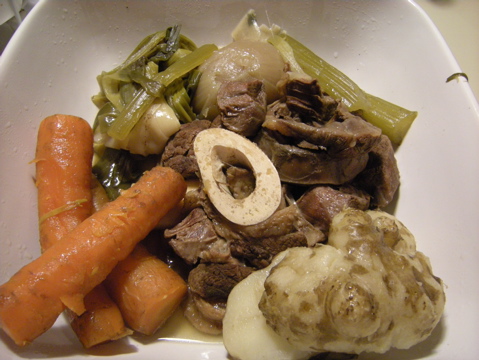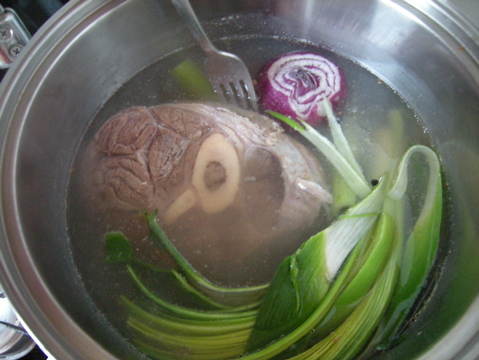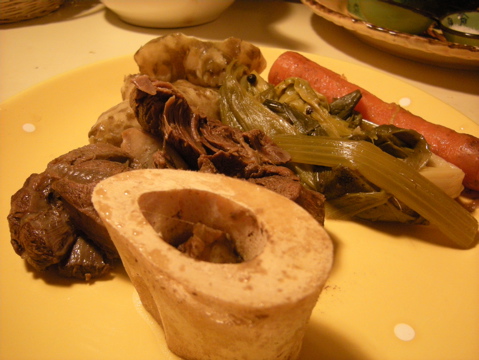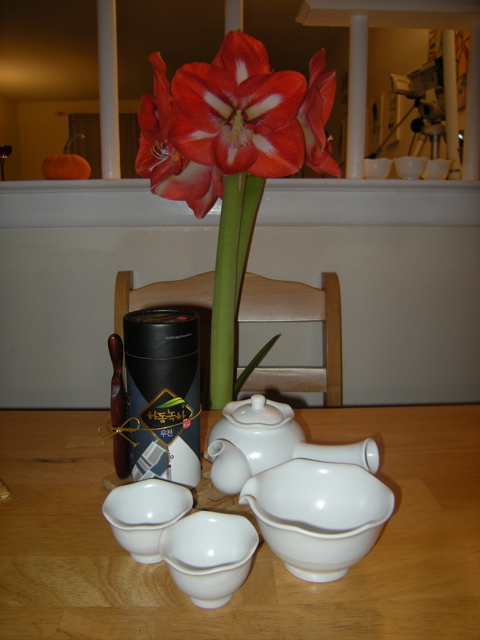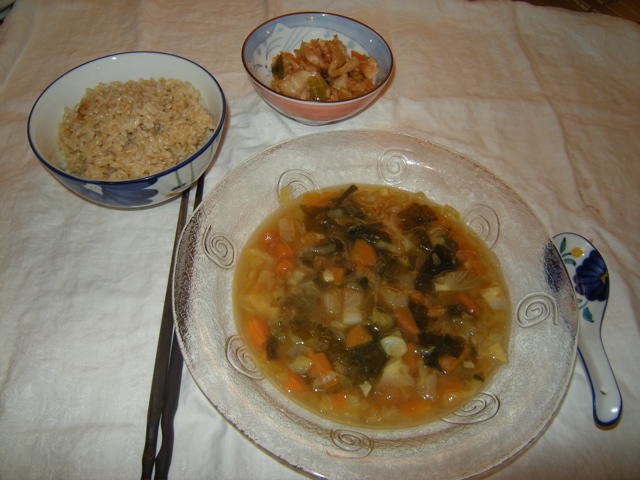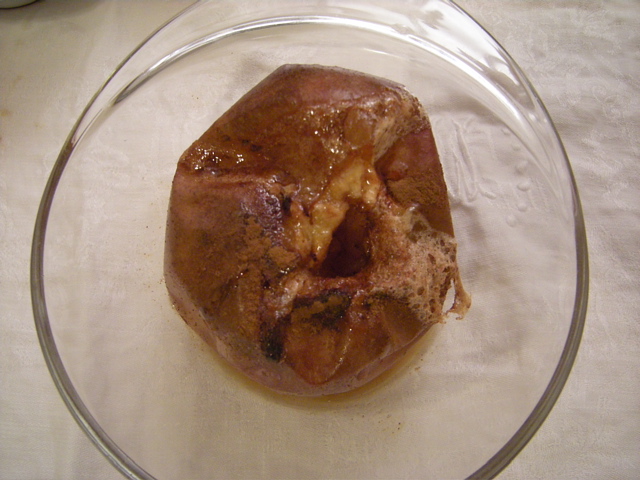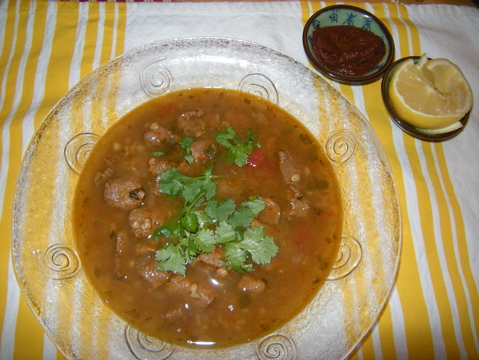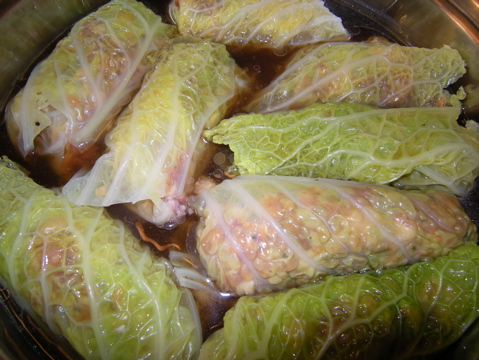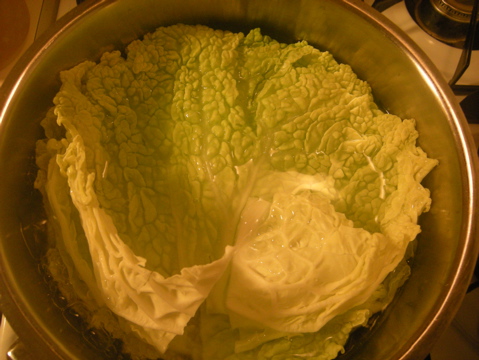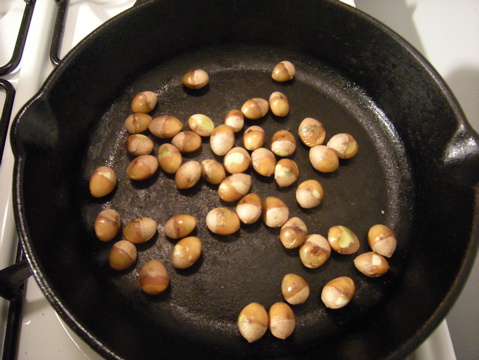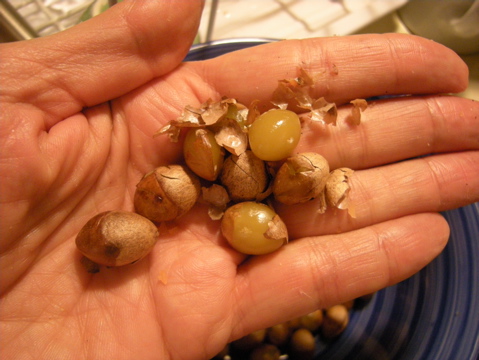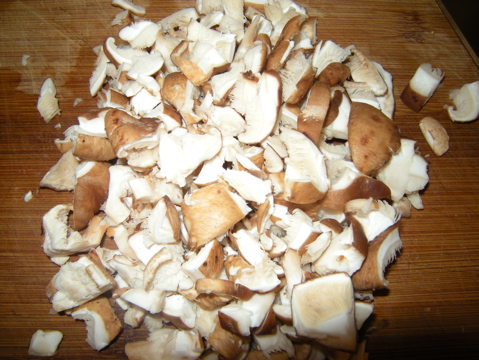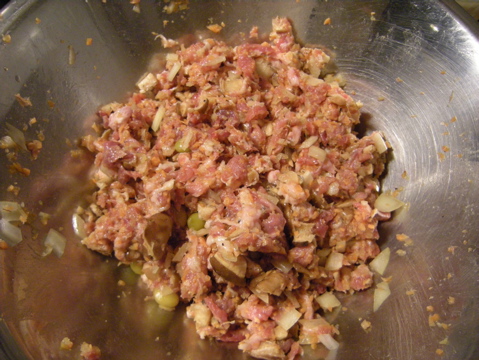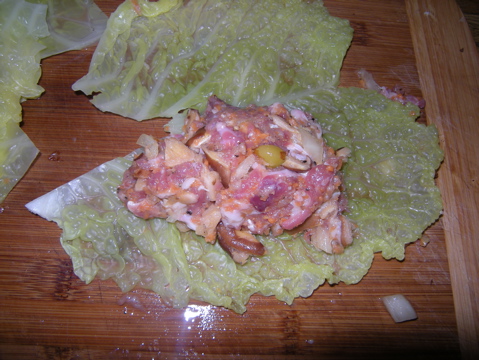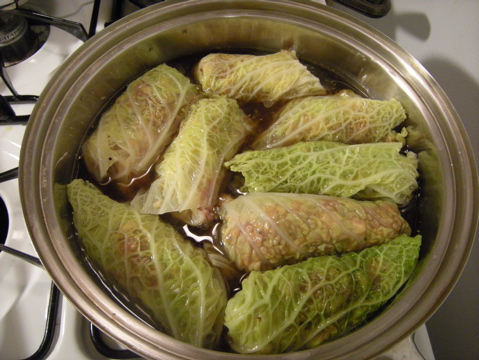
Les Croquettes de Morue sur un Lit de Verdure
Salt-cod cakes served with greens
Le Chapon de Noêl aux Marrons
Stuffed Christmas Capon with Chestnuts
&
Les “Racines” d’Hiver Braisées
Braised Winter Root Vegetables
La Crème Paysanne
&
Les Pescajous du Luchonnais
This is a festive winter dinner menu I made several time. I wrote it many years ago for a series of cooking classes untitled “The Demystification of French Cuisine” that I taught at the Café Capriccio Cooking School in Albany N.Y — someday I will retrieve my notes on that topic and will share them with you. Meanwhile here are the recipes for this menu. I think you will agree that it is a well balanced, not heavy, fun to cook & fun to eat menu! So try it and let me know. I have also included some historical background for dinner conversation!
First Course:
Les Croquettes de Morue sur un Lit de Verdure
Salt-cod cakes served with greens
Morue, a.k.a. baccalaú or salt-cod, is my favorite fish. I like the texture, the taste, the convenience, the flexibility. The use of cod can be traced as far back as the Upper-Paleolithic. And closer to us there is evidence that Basque fishermen came to the coast of Newfoundland to fish for cod way before Columbus had set foot on the American continent. Their first motivation had been to catch whales, but then they switched to fishing cod. It was safer and more lucrative.
There are many different ways to accommodate salt-cod; today we will make croquettes. This is a basic recipe that you will be able to reuse with other ingredients.
I like to serve the “croquettes” with a tossed mixed green salad dressed with a simple vinaigrette. (see my famous simple salad)
Ingredients:
1 small chopped red pepper
1/2 chopped Jalapeño pepper (optional)
1 cup chopped fresh parsley
2 eggs
1 bay leaf
3 cloves of garlic
1 whole medium onion
1 chopped medium onion
2 grated (raw) big russet potatoes
1 tablespoon saffron
salt and pepper to taste
The day before:
Rinse the filets and soak in plenty of cold water for about 12 hours, changing water three or four times.
The next day:
Place desalted cod, one onion and one bay leaf in a stock pot with plenty of water, bring to a boil. Reduce heat and simmer for 10 minutes. Drain and discard onion and bay leaf.
Mix all raw ingredients in a bowl, shred the cod in it. Mix it well. Shape the mixture into little cakes, use a ramekin if texture is too loose, and fry in a hot pan in olive oil about 5 minutes on each side (but that is going to depend on the thickness of the croquettes. I usually eat the first one to check texture and seasoning, and to judge the doneness).
Entrée
Le Chapon de Noêl aux Marrons
Stuffed Christmas Capon with Chestnuts
&
Les “Racines” d’Hiver Braisées
Braised Winter Root Vegetables
Our main course is going to be a capon stuffed with chestnuts, sausage and all kinds of delicacies. Capon is such exquisite poultry that it is saved for special occasions. Good, real capons are rare and difficult to raise and therefore difficult to get. Capons are a very ancient tradition: the creature came to us via the Romans, and the Romans learned how to fatten chickens from the Island of Kos in Greece — were Hippocrates (460-377 BC) lived and worked. The people from Kos, unlike the Romans, kept their chickens inside and gave them only selected grains and milk so they were getting fat quickly and their flesh incredibly delicate. Everybody in Rome started doing the same, keeping their chickens inside and so on, but it got to the point where so many people were doing this that Consul Caius Favius was obliged to pass a decree forbidding this practice for sanitary reasons. So now all the chickens were put back in the streets where they were easily distracted and didn’t focus on eating anymore, so they were not getting fat. Along came a veterinarian who had the idea to castrate the chicks so they would get bigger — and it worked!
Today we will serve the capon with winter root vegetables — they are delicious though much neglected and I also believe in using seasonal produce.
Le Chapon de Noêl aux Marrons
Stuffed Christmas Capon with Chestnuts
(You can find capon at the very fine purveyor D’Artagnan. A 12 pounds Capon will feed about 12 people.)
Ingredients:
1 Capon
1 Cheesecloth
1/2 stick Butter
Farce/Stuffing:
1 LB very good Bacon (no nitrates)
1 LB thin Sausage (plain)
1/2 LB ground veal
1 LB Mushrooms
25 Chestnuts cooked and peeled
2 medium onions diced
1/2 cup Armagnac (or cognac)
2 eggs
1/2 cup chopped Parsley
Salt & Pepper to taste
Lightly sauté onions, then add mushrooms, then bacon, then sausage, then 1/2 of the chestnuts. Flambé with the Armagnac. Place in a bowl, add the ground veal, the parsley, the eggs, salt and pepper. Mix well and stuff the Capon and saw it back.
Roasting:
Preheat Oven to 450 º
Butter or oil the roasting pan, place the capon in the oven and roast at this heat for 30 minutes. In a sauce pan melt 1/2 stick of butter and let it cool. Reduce the oven temperature to 325º, baste the capon with pan juices, and drape it with a piece of cheesecloth, soaked in the melted butter. Roast the bird, lifting the cheesecloth and basting every 20 minutes for about 2 1/2 hours or until thermometer registers 180ºF and when juices run clear when thighs are pierced with a skewer. Then remove from oven and from pan and let stand while you make your “jus.”
Jus:
1/2 cup Armagnac (or cognac)
2 cup chicken broth
2 finely chopped Shallots
30 Chestnuts
Remove all fat and burned pieces (if any) from roasting pan. Put the pan on top of a warm burner. Spread shallots in the pan and move around quickly. Flambé with 1/2 cup of Armagnac (make sure the fan is off when you flambé). Add the two cups of chicken broth, make sure all the caramelized juices are lifted off the bottom of the pan then add the chestnuts. Let simmer gently for a few minutes. Carve the Capon, display on a nice dish with the stuffing. Transfer the sauce to a dish, and serve!
Les “Racines” d’Hiver Braisées
Braised Winter Root Vegetables
This is a very simple dish that will enhance the flavor of your capon.
When I want to be fancy I “turn” the vegetable into olive shapes. Otherwise I cut them into 1/2 inch dice.
Use carrots, turnips or rutabagas, and parsnips -celery root is also an option. Put all your roots in a roasting pan with a little butter and water, salt and pepper, and braise at 300º in the oven until tender but not mushy!
Dessert:
La Crème Paysanne
Light Custard
&
Les Pescajous du Luchonnais
Do you still have a little room for dessert? Sorry, but I will skip the bûche de Noël —
I am not very found of it, I find it too sweet after such a meal. The pescajous will probably remind you of fried dough, they literally mean “little fishes.” This delicacy is unheard of beyond a 25 mile radius of my home town. Pescajous are served on all religious holidays. The biggest challenge about them is to be able to fill up a basket before anybody sees you making them. If just one person sees you, believe me, it will take you a long, long time to fill up that basket! Unless you can convince the little scavengers to wait for the crème paysanne to dunk them in!
Crème Paysanne
Boil 4 cups of whole milk then flavored with vanilla and rum.
In a bowl, separate 12 egg yolks from the whites. Reserve the egg whites and put the yolks in a bowl with 1 1/2 cup of sugar; whisk until it forms a ruban. Gradually add the warm milk. Mix well, keeping the pan on a very low heat and stirring continuously -making a figure 8- with a wooden spoon until the cream coats the spoon. Let cool off, and keep it in the refrigerator; cover to avoid skin formation.
Pescajous du Luchonnais
4 cups of flour
a pinch of salt
2 teaspoon Yeast
3 Eggs ( yolks separated and whites will be beaten)
1/4 cup melted butter
1 cup Milk
1 cup Sugar
2 teaspoon Vanilla and Rum
Put flour, salt, sugar in a bowl.
Proof the yeast in a little bowl.
Beat the egg white.
Mix egg yolks, vanilla, rum, butter and proofed yeast. Mix this into the flour mixture and add the beaten egg whites slowly.
Let the dough rest and rise for a couple of hours.
When ready to cook, heat 1 quart of oil (safflower or peanut oil) in a wok.
Turn the dough onto a generously floured surface, cut small pieces with a knife and shape by hand into 2 inch squares, 1/8 inch thick, and dip them into the hot oil fry them until golden (a few minutes are sufficient). Fry no more than 4 or 5 at a time and you will get best result if you keep moving then around in the oil with a skimmer. Take them out and place on an absorbent paper towel to remove excess oil and start piling them up in a basket; Sprinkle caster sugar as you go along; they are better warm, and do not forget to dunk them in the crème paysanne!
Bon Appetit!


